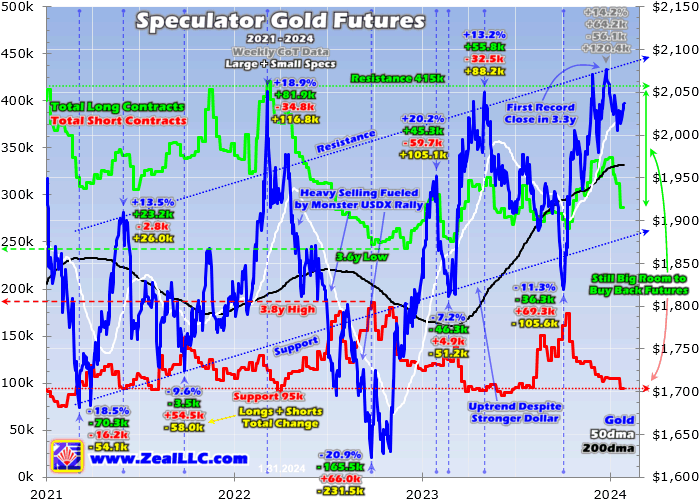Gold resists Fed chair

Gold powered higher this week right through a surprisingly-hawkish FOMC meeting, a bullish omen. The FOMC statement had big changes arguing for higher rates for longer. Then the Fed chair himself poured cold water on traders’ high expectations for an initial rate cut at the FOMC’s next meeting in mid-March. Yet despite major market reactions to that, gold not only weathered that hawkishness but rallied anyway.
For the past couple years or so, gold price action has been dominated by gold-futures speculators trying to game the Fed. They closely watch the US dollar’s fortunes, then do the opposite with super-leveraged gold futures. So Federal Open Market Committee decisions, top Fed officials’ speeches and their future rate projections, and major economic data affecting those has spawned big-and-heavy gold-moving trading.
This week’s impressive gold strength despite a hawkish FOMC is a fascinating plot twist in this saga’s latest thread. Like all good stories, some context makes this week’s gold action much more interesting. Leading into the previous FOMC meeting in mid-December, futures-implied rate-cut odds were muted. Traders figured there was about a 40% chance a new cutting cycle would be born at the March FOMC meeting.
And they expected about 110 basis points of total rate cuts in 2024, or a little over four at 25bp each. Gold was trading at $1,980 on FOMC eve, and the benchmark US Dollar Index that fuels much gold-futures trading ran 103.8. But the FOMC really pivoted dovish that day with a trifecta of surprises, from the FOMC statement to Fed officials’ rate projections to the Fed chair at his post-meeting press conference.
That statement added a qualifier making further rate hikes sound less likely, top Fed officials cut their year-end-2024 federal-funds-rate outlook by 50bp in the dot plot, and Jerome Powell said rate-cut timing had been discussed at that day’s FOMC meeting! From that presser, the Wall Street Journal’s widely-followed Fed whisperer tweeted “The Powell pivot begins.” Markets reacted violently to that dovish shift.
That day gold blasted 2.3% higher to $2,024, while the USDX plunged 0.9% both that day and the next to hit 102.0. Rate-cut odds soared, with March’s chances shooting over 75% and traders expecting 150bp of cuts this year! Over the subsequent couple weeks or so, those FOMC-induced trends continued. Gold surged up to a new nominal record high of $2,077, while the USDX plunged to a 5.3-month low of 100.9.
Those March rate-cut odds topped out near 90% in late December, while futures-implied rate cuts in 2024 soared to 170bp in mid-January! The latter was particularly grating to top Fed officials, as they had only forecast 75bp of cuts in their mid-December dot plot. So those guys fought back, unleashing a united phalanx of hawkish Fedspeak. That certainly had an impact on rate expectations, the US dollar, and gold.
At worst gold pulled back 3.4% in mid-January, which was really mild considering that hawkish onslaught. The USDX crested a few trading days later surging 2.6% in a little over several weeks, looking like a bear-market rally. And leading into this week, March rate-cut odds drooped back to 36% with traders looking for 132bp of total cuts in 2024. But those five-plus 25bp cuts were still much bigger than Fed officials’ three.
So trying to reset traders’ rate expectations, the FOMC came in guns-blazing this week. As this was one of the every-other meetings without a dot plot, they couldn’t push back on that front. They likely wouldn’t have reduced their 75bp of expected hikes in 2024 anyway, as their speeches since mid-December have continued supporting that. Without dots, they added a hawkish higher-rates-for-longer passage in their statement.
It declared, “In considering any adjustments to the target range for the federal funds rate, the Committee will carefully assess incoming data, the evolving outlook, and the balance of risks. The Committee does not expect it will be appropriate to reduce the target range until it has gained greater confidence that inflation is moving sustainably toward 2 percent.” That still looks some ways off per recent inflation data.
The latest CPI and PCE headline inflation reads showed US prices still climbing 3.4% and 2.6% year-over-year. Their core variants excluding food and energy that Fed guys are more interested in were running +3.9% and +2.9% YoY. Economists warn reducing inflation gets harder the lower it goes, so it is far more difficult to drop from 3% to 2% than 6% to 5%. So regaining the FOMC’s 2% target won’t be easy.
Then the Fed chair doubled down in his usual post-FOMC-meeting presser. His prepared remarks first confirmed the FOMC still plans to launch a new cutting cycle later this year as Fed officials expected. “We believe that our policy rate is likely at its peak for this tightening cycle and that, if the economy evolves broadly as expected, it will likely be appropriate to begin dialing back policy restraint at some point this year.”
Yet right after that he warned, “But the economy has surprised forecasters in many ways since the pandemic, and ongoing progress toward our 2 percent inflation objective is not assured. The economic outlook is uncertain, and we remain highly attentive to inflation risks. We are prepared to maintain the current target range for the federal funds rate for longer, if appropriate.” Powell then added a new confidence theme.
“The Committee does not expect it will be appropriate to reduce the target range until it has gained greater confidence that inflation is moving sustainably toward 2 percent. We will continue to make our decisions meeting by meeting.” Later in response to reporters’ questions, he said the FOMC needs to see more disinflation progress to gain the confidence necessary to start cutting. But a bigger bombshell came!
The Fed Chair has emphasized for years that FOMC decisions are made one meeting at a time based on economic data. So he has been loath to telegraph any potential actions at future FOMC meetings. Yet this Wednesday, Jerome Powell surprised saying “Based on the meeting today, I would tell you that I don’t think it’s likely that the committee will reach a level of confidence by the time of the March meeting.”
Since Powell’s pressers can really move markets, I watch all of them live in my line of work. Hearing him all but rule out a March rate cut was stunning! All that was pretty-darned hawkish, hammering March rate-cut odds to 38% and leaving 2024 expected cuts near 141bp. Emphasizing how serious a hawkish surprise that was, the flagship S&P 500 stock index plunged 1.6% into close on the Fed chair’s comments!
That easily could’ve lit a fire under the US dollar and crushed gold. While the latter did fall from $2,045 just before Wednesday’s FOMC decision to $2,037 on close, that still made for a slight 0.1% gain across a quite-hawkish FOMC! And the US Dollar Index only climbed 0.2% to 103.6, merely revisiting its bounce high hit over a week earlier. Gold had resisted the Fed chair despite being mired in bearish psychology!
Post-FOMC market reactions often aren’t fully apparent until the end of the subsequent trading day. That gives overseas traders time to react overnight, and American traders more time to digest the implications of whatever the Fed did. At noon Thursday as I pen this essay, gold had surged 1.1% near $2,060. And the USDX had dropped 0.5% around 103.1. Neither were responding as usual to a hawkish Fed surprise!
Why? After bouncing hard out of really-oversold levels in late December, the US Dollar Index quickly grew overbought by mid-January. That dollar surge stalled out at the USDX’s 200-day moving average over two weeks before the FOMC. 200dmas often prove major overhead resistance in bear-market rallies, and the US dollar is almost certainly in a bear. So the USDX rally was running out of steam before Powell.
And while trying to squash any expectations for a March rate cut was hawkish, the Fed chair had plenty dovish to say. He declared the FOMC indeed does plan to start cutting later this year, but it needs to see more disinflation first. He said the Fed doesn’t require faster declines in inflation, merely continued progress back towards that 2% target. Powell said more inflation reports trending that way would build confidence.
The USDX not spiking certainly helped gold stay resilient, as gold-futures speculators weren’t scared into dumping more contracts in the FOMC’s wake. And as I explained well before the Fed in my essay last week on gold’s mild pullback, spec gold-futures positioning was already very bullish for gold leading into the FOMC. This chart updates that analysis with another weekly Commitments of Traders report’s latest data.

While not released until late Friday afternoons, CoT reports are current to Tuesday closes. So the latest spec-gold-futures-positioning data before this essay was published was as of January 23rd. That day gold closed near $2,028 after recovering from its mild-pullback low. In the next still-not-yet-reported CoT week ending FOMC eve, gold merely climbed 0.4% to $2,036. So speculators’ bets likely didn’t change much.
Gold has been powering higher in a young upleg, already rallying 14.2% at best over 2.7 months into late December. With two new nominal record closes already, this upleg has high potential to grow into a major one. In recent years gold has seen massive 26% to 43% gains in those! Major gold uplegs are fueled by three sequential progressively-larger stages of buying. Specs’ gold-futures trading drives the first two.
Gold uplegs’ initial surges out of major interim lows are driven by gold-futures short-covering buying. That tends to mostly exhaust itself over a few weeks or so. The red line above shows that’s exactly what drove gold’s sharp V-bounce out of early October’s anomalous lows. That short covering finally ran its course in this latest-reported CoT week, with total spec shorts falling back to their major secular support at 95k contracts.
Stage one propels gold high enough for long enough to entice back long-side gold-futures specs. They command much more capital than the short guys, making stage two much larger. It usually takes a few months or so for that long buying to largely exhaust itself. That happens when total spec longs challenge their secular upper resistance near 415k contracts, which wasn’t even close leading into this latest FOMC meeting.
Just over a week before it, total spec longs had plunged to just 286.7k contracts! That was a whopping 128.3k under that gold-upleg-topping resistance, massive room for these super-leveraged traders to keep buying longs to normalize their gold bets! Considered another way, this young gold upleg was born in early October when total spec longs were 264.8k. That made for stage-two buying potential of 150.2k to 415k.
Of that huge likely capital firepower available for buying longs, over 85% remained untapped just one week before Wednesday’s hawkish FOMC surprise! So the gold-futures specs had far more room to buy than to sell, helping explain gold’s counter-Fed reaction. Unfortunately we won’t know how much post-FOMC buying they’ve done until next Friday, when positioning data for the first post-FOMC CoT week gets released.
So gold was able to resist the Fed chair because speculators’ collective gold-futures bets were already pretty bearish on gold leading into this week’s FOMC meeting. While they sure could’ve dumped more longs on that hawkish surprise, they had way more room to buy than sell. Thus gold was able to rally even with the Fed chair taking a March cut off the table. This impressive resistance has bullish implications.
Gold-futures long specs love chasing upside momentum, piling in to ride gold rallies amplifying them. With gold defying this hawkish FOMC, traders’ near-term confidence in it will mount. It won’t take much more long buying to catapult gold to more new nominal record closes above late December’s $2,077. More records will greatly boost bullish financial-media coverage on gold, spreading awareness of is upleg.
The longer and higher gold rallies, the more speculators will want to buy it. The more gold futures they buy, the bigger gold’s upleg will grow. This virtuous-circle dynamic is powerful in normal gold uplegs, but new record highs greatly intensify it. Those new records also pop gold back onto investors’ radars, and their huge stage-three buying dwarfing all gold-futures buying hasn’t even started yet and is all still coming.
Gold’s impressive counter-Fed rallying this week could prove an important psychological inflection point. Gold’s latest surge despite a big hawkish surprise ought to help convince gold-futures specs this young upleg still has lots of room to run. That will motivate them to pile back into longs, amplifying gold’s gains. As its upleg resumes powering higher on balance, the resulting new records should attract lots of new traders.
The biggest beneficiaries of much-higher prevailing gold prices as that momentum buying resumes will be the gold miners’ stocks. The GDX majors soared 134.1% during gold’s last mighty 40.0% upleg in mid-2020 seeing new records fueled by investors flooding back in. Smaller fundamentally-superior mid-tiers and juniors tend to well outperform, and our newsletter trading books are currently full of cheap great ones.
The bottom line is gold resisted the Fed chair this week. This latest FOMC meeting was quite hawkish, as top Fed officials fought back against traders’ big rate-cut expectations. The statement and Fed chair both emphasized the FOMC doesn’t yet have enough confidence in disinflation trends to start cutting soon. Then the Fed chair unusually all but ruled out rate cuts starting in March, slamming traders’ hopes.
Yet despite big reactions to this hawkish surprise in rates and stock markets, the US dollar didn’t surge and gold didn’t plunge. The former had already stalled out after bouncing hard, while speculators’ collective gold-futures bets in the latter were already bearish. So gold surged out of the FOMC, which should really boost traders’ confidence in chasing its upside momentum. That likely rekindled gold’s young upleg.
(By Adam Hamilton)
More News
Northern Star crosses last major hurdle in De Grey takeover
April 16, 2025 | 03:46 am
Pilbara Rail Maintenance wins operational excellence award at Rio Tinto supplier gala
April 15, 2025 | 05:07 pm
{{ commodity.name }}
{{ post.title }}
{{ post.date }}




Comments
Gold Headlines
Interesting to see it here. Yesterday $DXY was slightly up within 15 mins timeframe but then it again stalled. Precious metals are taking a hammering but this usually does happens every weekend. Waiting for Monday opening bell.